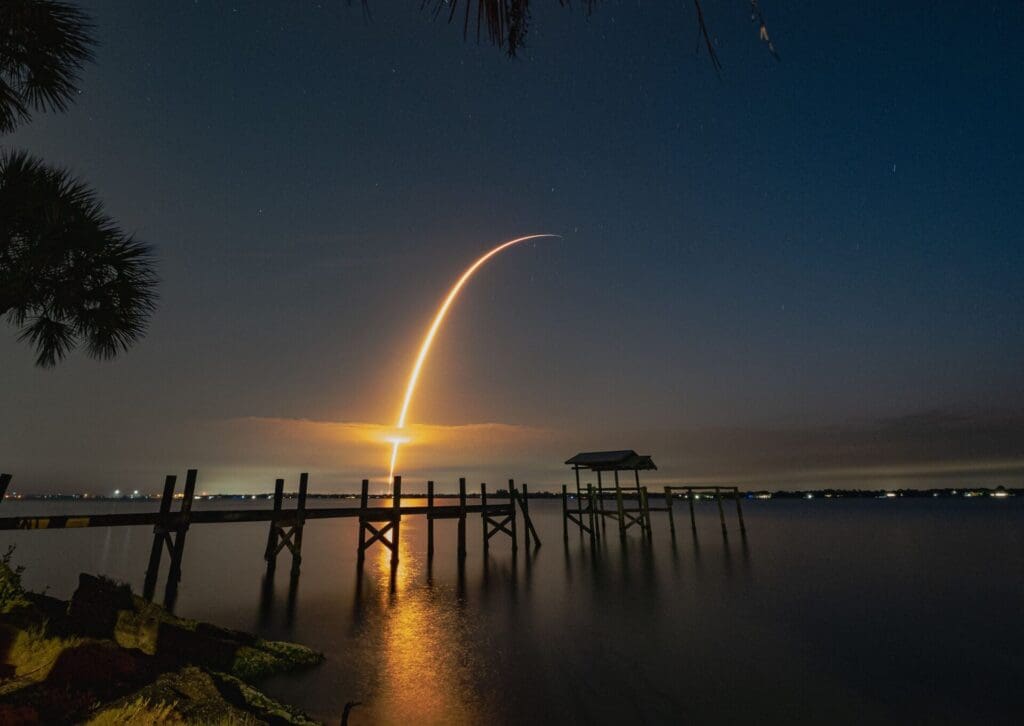Fast, reliable Internet access anywhere in the world. It’s been the unattainable ideal for years—even since public Internet access has existed. In the beginning, increasing Internet access generally meant little more than distributing and selling dial-up modems: since landline telephones were more or less a universal feature of households and businesses, a dial-up modem hooking into your phone line gave you instant Internet at “as good as it gets speeds.” But, the standard for Internet speeds has increased since the early 90s… and the intermittent service of dial-up is incompatible with many modern websites and services. So, as we move further and further from ubiquitous but slow dial-up, a gulf erupted between Internet options: do you want fast Internet or Internet anywhere? How much “fast” can you get before you lose the “anywhere”? SpaceX tried with their Starlink product and it revealed some key findings.
Internet Everywhere
Of course, for most of us, the fastest we get is hardline fiber Internet, but that doesn’t reach everywhere. Conventional cable Internet also promises perfectly-acceptable-for-most-uses (but slower) speeds and is available in more areas. But what about when there isn’t a cable run to your location? Whether you live in a rural area and need Internet service to your home or if, like us, you need Internet for events and work in far-flung and remote locations, the options become much more limited.
For the longest time, your best option was conventional satellite Internet service like HughesNet. Though these systems are remarkable and have been around for over 25 years now, they’re not perfect and not exceptionally fast. To leapfrog the limitations of satellite Internet, “new-space giant SpaceX has unleashed the Starlink satellite constellation over the past four years, promising both higher speed and lower latency than its predecessors. But does it deliver on this promise? Is Starlink good enough to replace conventional Internet service? Is it right for our high-intensity use case? Let’s dive in and see.
The Problem with Satellite

On its face, satellite internet seems like the solution to everyone’s problem. You don’t need to run a cable anywhere! All you have to do is stick an antenna in a place with a good view of the sky and in comes the signal. No sweat! …Well, it’s not that simple. Or effective. One of the biggest issues with satellite internet is a simple matter of physics – the fact that radio signals travel at the speed of light.
This presents very little issue for conventional wired and wireless terrestrial Internet. A signal traveling at the speed of light can go all the way around the world in just 0.13 seconds, and any one part of a signal carrying Internet service at most has to travel half that distance. Disregarding latency from servers and network equipment, you’re guaranteed to have a low delay between a signal being sent and it arriving on your computer.
“Original” Internet Satellites
Meanwhile, the “original” type of Internet satellites (like HughesNet) orbit the Earth at geostationary altitude in order to maximize coverage over a specific area. Geostationary orbits are just over 22,000 miles high—compare that to the 25,000-mile circumference of the Earth. In the absolute shortest signal path for Internet satellites, where both the transmitter and receiver are directly underneath the satellite and the signal doesn’t have to hop between satellites, your Internet signal has a minimum of a quarter-second delay to make it to you.
In reality, it can be up to three times that before accounting for network hardware delays. While this sort of latency is acceptable for browsing, it makes low-latency use cases like gaming, streaming, and video calls more or less unusable. Even if the satellites had terrific bandwidth (which they usually don’t), the usability of your satellite Internet is severely limited. Is there a way to fix this?
The Solution
You may have already guessed it. Why not just make the Internet-serving satellites orbit closer to the Earth? That way, your signal (in theory) doesn’t need to travel nearly as far. It could be almost as time-efficient as a direct line run along the surface of the Earth from the server to you, without having to actually run a cable! While this is technically true, this also presents some major issues. A satellite at low altitude can see much less of the surface of the earth than one in geostationary orbit, in the same way you can see less of the Earth from a ladder than you can from an airliner!

What this means is you need more satellites to cover the same area by a huge margin. For example, HughesNet uses just one satellite to cover all of North and South America from geosynchronous orbit. Meanwhile, the Teledesic program, one of the first (abortive) low-altitude satellite Internet services, would have needed 840 satellites to cover the same area! Starlink, which orbits at an even lower altitude than Teledesic, is planned to have a staggering 12,000 satellites to fully complete its network. At present, there are over 3,300 Starlink satellites in orbit, and SpaceX is launching more at a staggering pace. In 2022 alone, 33 orbital launches were made for Starlink, each with 30 to 55 satellites deployed at once. That’s a truly historic engineering achievement.
Starlink’s Promises
What this gives Starlink users is, in theory, high-speed and low-latency Internet access anywhere their antenna can see the sky. Though only about one-fourth of the satellite network has been launched, access is still essentially continuous with few gaps in coverage. The low orbiting altitude does mean that your antenna has to constantly switch its “target” satellite as they come up over the horizon and pass out of view, but it provides an experience nearly on par with cable broadband.
Additionally, the system still being essentially brand-new means your service is being provided by cutting-edge hardware, from the relays in space all the way down to your router at home. As a company that serves Internet to customers in remote event locations, this is a godsend. Doubly so because we need fast Internet to livestream and broadcast those same events, so a Starlink set can give us what we need simply and easily when there isn’t any other connection available.
Sounds terrific! What’s not to love?
Why We Don’t Love Starlink (For All Our Internet Needs)
In reality, signing up for Starlink and actually using it feels like a wish from a spiteful genie—you get what you asked for, but in a way that ends up making your life worse. But as it turns out, using Starlink may not just make your Internet experience worse, it may make things worse for a lot of people. “But you were so positive in the previous section!” Well, every good thing we noted there has a dark side. Let’s break it down.
As we noted, Starlink is brand-new—technically, it’s still a work in progress. What’s more, Starlink isn’t its own business, it is strictly an offshoot of SpaceX with different branding. If you want to send in an email for support, you’ll get a response from SpaceX! …That is, if you even get a response.
Starlink’s Support
It seems as though the company is focused more on getting satellites and dishes out the door to customers than supporting the customers they have. Starlink’s technical support is rapidly becoming notorious for ignored support tickets, long response times, inaccessibility (you can’t request support without an account, and your account doesn’t work unless you’re a paying customer—so what do you do if you want to restart service after cancellation?), and a general inability to solve any issue other than “help me buy more hardware.” In effect, Starlink usually works well thanks to its new hardware and software, but when it doesn’t work, you may as well just cross your fingers and hope the issue resolves itself.
Does Starlink work?
That begs the question – does Starlink usually work well? In some places, it sure does. If you can place your antenna high up with no obstructions, it has little trouble tracking satellites and piping Internet into your home. However, there’s a technical detail of Starlink’s satellites and receivers that intrinsically hold the system back in many areas.
The radio frequencies they use to transmit their signal are in the Ku- and Ka-bands. These frequencies are—by sheer force of physics—very vulnerable to being distorted or blocked by something very common: water. Clouds, rain, snow, the water in the leaves of trees, people… water is all around us. Starlink receivers struggle to pick up satellites at low angles and long distances whenever any of that water is in line of sight—and there’s no way to fix this. This is something that Starlink fails to note in any of their support articles or instructions, but we can confirm from using Starlink all over the country in all sorts of weather.
What was once a clean and quick Internet connection can suddenly nosedive into dial-up speeds as the weather shifts and your receiver can no longer perfectly track its nearest satellite. (And since there’s still only about 25% of the total planned network in orbit, there isn’t enough redundancy for an antenna to try a different satellite.) To put it lightly, this isn’t ideal!
Should You Love Starlink?
Okay, so it isn’t right for us in all applications. But what if you live somewhere that isn’t susceptible to the connection issues that hold it back? You could still have fast and low-latency Internet without trouble, if you can live with ineffective customer support. That’s fine, right? Well, there are more caveats.
As we’ve said a few times now, the Starlink network has around 3,300 satellites in orbit, but it’s planned to consist of 12,000 total once complete. And that’s the operative word: complete. Starlink isn’t nearly finished, but it’s still sending hardware to anyone who’s willing to pay for it. As the limited number of satellites have to accommodate more and more customers, network speeds have been perceptibly dipping for Starlink customers. To combat this, Starlink has introduced data limits, but this doesn’t seem to be the panacea it was expected to be. Starlink customers (including us) haven’t seen any speed increases yet, and likely won’t unless the network is completed faster than new customers join.
Troubles with Starlink
Look back at the satellite and launch statistics. 33 spaceflights were made in 2022 just for the sake of launching Starlink satellites. Sure, that doesn’t sound like a lot… unless you learn that there were only 180 launches into orbit total for that year. 18% of all flights into orbit were for Starlink! Well, that’ll go down once the whole network is established, right? Unfortunately not.
The very low altitude these satellites orbit at is well within the thermosphere—a low-pressure but still extant part of our atmosphere. This means the satellites are under constant drag, just as aircraft are in the lower atmosphere. They must constantly “reboost” to avoid slowing down and burning up—and with no way to refuel, they’ll eventually fall out of the sky, requiring replacement with a new launch of satellites.
This is a constant money sink and an environmental hazard. Each Falcon 9, SpaceX’s rocket used for most Starlink launches, burns nearly 500 tons of kerosene and liquid oxygen to fly to orbit. You do the math. That’s a lot of fossil fuel! And the network is still only one-fourth of the way to completion.

Streaks left behind
There’s also a strange but deeply concerning consequence to all of these Starlink satellites. Ever looked up at the night sky and seen the dim light of a satellite passing overhead? Sure, it looks beautiful to us on the ground… but these little lights cause trouble for science. The most powerful telescopes in the world, whether they’re looking for new planets and stars millions of light-years away or scanning for potentially dangerous asteroids much closer, take long-exposure photographs of the night sky to pick up as much light as possible.
The reflected light of a satellite shows up as a bright streak on the telescope’s view, which can potentially ruin crucial scientific observations. And a cluster of Starlink satellites flying in formation? Well, say hello to a dozen or more streaks across your telescope’s picture.
As more and more Starlink satellites are launched, this problem will get worse and worse. It’s being referred to as an existential threat to Earth-based telescopes which could have a catastrophic effect on astronomy and space exploration. Starlink promises to make new satellites darker and less reflective, but that doesn’t fix the ones already in orbit—nor does it completely solve the issue. In effect, Starlink is building a chain-link fence across our view of the largest landscape in the universe. Even if you love having satellite Internet, it’s hard to ignore this issue.
Shattered Dreams
Here at BCC Live, we thought Starlink would be a game-changer for our streaming services. Plug-and-play Internet anywhere that’s fast enough to livestream the events we go to? Sign us up! Over the past year, we took Starlink hardware to several events and enjoyed great successes—but also suffered nearly as many failures. And with the lack of support from Starlink themselves, we had to improvise solutions and determine on our own why things weren’t working. The number of headaches wasn’t nearly worth the performance when the system was operating at its people.
Ultimately, the answer for us to the question of how to get Internet when you can’t get a wired connection ended up being the same as it always was: relying on the cellular network. A Netgear Nighthawk mobile router, or another piece of hardware like it, can use 5G cellular service to provide Internet at solid speeds reliably—only encountering issues in the most densely-packed environments. Even an older 4G cellular router is good enough for Internet browsing and livestreaming, with lower latency than satellite service.
As the cellular system is managed by multiple companies and powers a myriad of technologies, there’s always support available and maintenance teams hard at work—and they don’t need to fly into space to fix a connection! As 4G and 5G coverage is expanded more and more across the United States and beyond, it’ll just keep getting better and more reliable. Given the downsides of Starlink in comparison, and the low likelihood it’ll quickly improve, we lean toward using those technologies (especially bonded cellular for streaming) over Starlink when possible.
Need help with video production, broadcasting and live streaming, or event production? Contact Us!
